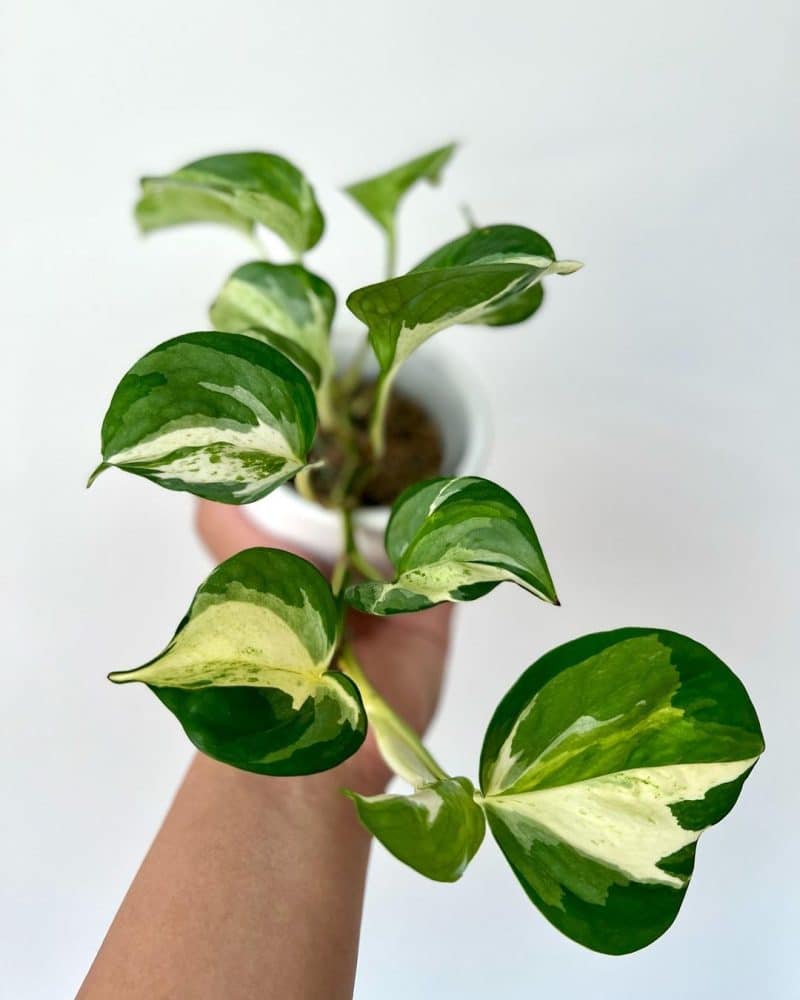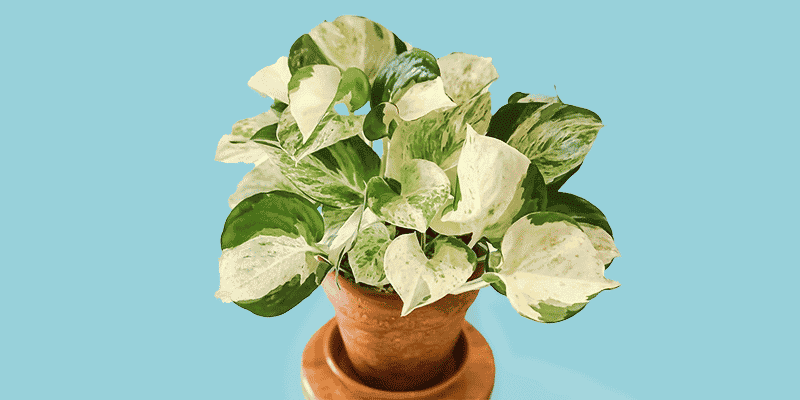I’m beyond excited today, I finally get to cover my absolute favorite pothos variety: the Manjula Pothos. This is the indoor plant I get the most questions about at home, and it’s easy to see why.
It features a unique, brighter variegation than other pothos varieties, with leaf shape patterns not previously seen.
The best part for plant lovers who like to share? They’re specifically engineered from clones to be reproduced and stable over many generations. Propagation? So easy!
In this article I’ll cover: Manjula Pothos care, propagation, and a few tips on dealing with brown leaves.
Table of Contents
Manjula Pothos Care Guide
History, habitat, and characteristics
The Manjula Pothos (Epipremnum aureum manjula) plant was originally developed as a patented plant in Mumbai, India by Ashish Hansoti. It was designed as a reproduction of the Epipremnum pinnatum plants but with brighter variegation, improved survivability, and unique leaf edges.
Ashish experimented with thousands of plants and clones over the year until coming across this cultivar (HANSOTI14) which is now propagated through stem-cutting clones where it’s been steadily taking over garden centers throughout the world and replacing other popular pothos plants.
There are a few similar pothos varieties and we’ll cover those later in the article, including brand-new plants being released by the University of Florida with a very worrisome downside.
The Manjula Pothos features large, wavy leaves, and the healthier your plant the more of its signature creamy spots you’ll find.

Pothos ( Epipremnum aureum) is an evergreen vine that can grow more than 50 feet tall in the wild.
Indoors? A little shorter.
If you’re familiar with other Pothos (Pearls & Jade, N’Joy Pothos) you’ll notice a lot of similarities.
Satin pothos (featured in this article) or Cebu blue pothos? Not as much.
Manjula Pothos, like most variegated pothos, grows pretty slowly. That same variegation responsible for its attractive look also gives the plant less chlorophyll, which means less growth potential per leaf surface area.
Light
Manjula Pothos can thrive in a variety of lighting conditions except for one: direct sunlight. Exposure to too much direct light will be pretty obvious, you’ll see the edges fray and the white parts of leaves burn. Too little light and you’ll see reduced variegation.
If the Manjula Pothos is getting too much indirect sunlight you’ll start seeing leaves turning completely green as it attempts to protect itself. You’ll also see dense foliage accumulate as it tries to make use of all the light you’re sending its way, so if you’d like a denser growth, more light is the answer.
Like other plants, with a pothos the more variegated leaves it has it is the more light it will require. As we mentioned above, more white variegation means less chlorophyll, so: let it drink in the light!
The ideal location for your Manjula Pothos: anywhere with a large amount of indirect light. As we’ll cover later in the humidity section, a bathroom with an opaque window makes a great place to keep this plant (and you’ll benefit from its air-filtering capacities!).
Water
Watering a Manjula Pothos plant is largely based on observation, if you keep an eye on the plant’s leaves and soil they will tell you exactly when it wants water.
To figure out if it’s time to water, probe the soil with a single finger. You should feel 1-3 inches of dry soil level then moist soil underneath.
You can also think of the year as split into two parts: the growing season of the spring/summer when you’ll be watering more frequently and then the fall/winter when water needs will be reduced.
Some key points:
- Depending on the quality of your tap water, you may notice some burning around the edges of leaves if there’s too much salt build-up. You should first experiment with filtered water, and if that doesn’t fix it within a few weeks you might need bottled water.
- Manjula Pothos are pretty forgiving, and this is a big draw of the entire pothos plant family. If your soil dries out, you’ll notice the leaves curling/fraying at the edges.
- Absolutely avoid standing water, and don’t be afraid to let the soil dry out a bit between waterings in the growing season.
Temperature and humidity

Like other variegated pothos, the Manjula is a tropical plant and grows well in higher temperatures. If you keep the temperature steady and avoid direct sunlight it should do well between 65-80 degrees.
Let’s talk about humidity: this is a growth accelerator and will intensify its variegation with more vibrant leaves. If you’re having issues with growth and new leaves, check the humidity levels first: at least 50% and this plant will thrive..
Soil and planting
Whether you’ve acquired your Manjula Pothos from a nursery, friend, or recent water propagation, you’ll soon find that it needs more than just water… it needs soil and nutrients.
Our favorite fresh soil mixture for a Manjula Pothos is a combination of:
- 25% – moisture control soil
- 25% – cactus soil
- 25% – perlite
- 25% – sphagnum moss
Feed with fertilizer every 2 weeks in spring and summer, not in fall or winter.
Another option is going with a soilless potting mix like LECA, but you’ll need fertilizer because the nutrients have to come from somewhere. LECA can be a bit difficult to get started with, you’ll want fertilizer, pots, water gauges, and of course the LECA itself. I highly suggest beginning with a starter kit.
Pothos plants typically prefer a slightly acidic soil, the Manjula Pothos grows well in a soil between 6.1 – 6.5 pH. The above mixture should place you well within that range, but so will the most common soil mixtures available from a garden center. If you notice slow growth or yellowing leaves, you might have a soil that’s too alkaline: just add more sphagnum moss to the top of the mixture.
Propagation guide
Here I’ll cover pothos propagation and how to grow your own plants indoors. For the Manjula Pothos I recommend stem cuttings as the easiest propagation method. Let’s dig in:
Stem cutting pothos propagation. Take a pair of scissors and cut 3-5-inches of healthy stem, placing each Manjula Pothos cuttings in a jar of water. Like you’d generally care, you’ll want to give the propagation plenty of light but avoid direct sunlight. You should see roots show quickly, and around a month later you’ll be able to transplant the cutting into soil.
Depending on the amount of light and temperatures you’ll see a time to rooting average of either 20 days during the summer or closer to 40 days under winter conditions.
Manjula Pothos plants do feature an aerial root structure, and if you can find one of these to make a cutting from you should have a bit of an easier time. Make sure to completely saturate the soil after you transplant from water for a week or so, and after that you can water normally so that we don’t shock the young roots and avoid introducing root rot.
Common issues

Here I’ll cover the common issues that pothos varieties have, but specifically the most common Manjula Pothos issues I see are:
- Brown spots appearing on leaves
- Completely green leaves
- Root rot
- Leaf spotting
- Pests like spider mites and mealybugs
OK, let’s explore:
Why does it have brown spots on leaves?
There are a few causes for brown spots on a Manjula Pothos, but fortunately, all of them are easy to resolve.
- If you’re watering your pothos with tap water, you could be seeing salt/mineral build-up: try filtered or distilled water.
- If the browning is exclusively on the whites of the leaves, you’ll want to reduce the amount of direct light. Excessive indirect sunlight often results in newer green leaf growth instead of browning.
- If you are using a spray bottle or misting the plant, you could be seeing the beginnings of bacterial growth. Check the root structure to make sure they look firm and healthy. If they look rotting trim them back immediately.
- If you’re still stumped on the issue, are already using bottled water, and are sure the lighting is appropriate, I’d check drainage and humidity levels. You may have your Manjula Pothos in a location that’s too dry or in a planter that isn’t clearing its water quickly enough.
With any problem like this I always recommend taking your time and not changing too many variables at once. It’s better to look carefully at your plant and really diagnose the issue than to throw the kitchen sink at it.
Diseases and pests
Like many indoor plants, the Manjula Pothos can suffer from many common houseplant issues such as:
- Root rot
- Leaf spotting
- Spider mites, scale insects, or mealybugs.
What these all have in common is they typically occur in a weakened plant and aren’t the primary cause of the problem.
Conclusion
Manjula Pothos is probably my favorite Pothos cultivar right now. It’s easy to take care of, thrives as an indoor plant, and it recovers pretty easily from any mishaps.
One recommendation: play around with the amount of light you give your Manjula. As the levels change (over a few weeks) you’ll notice the color on the leaves changing. Experiment and design your own plant!
That’s it for our Manjula pothos care guide! If you have any questions that weren’t answered, read ahead for our FAQ. Otherwise, feel free to drop a line with any comments or questions you might have.
FAQ
What is a mutated Manjula Pothos plant
“Mutated” Manjula Pothos plant is a rare cultivar of the pothos that was developed by Dr. Chen at the University of Florida. This variety does have an issue where plants stop producing chlorophyll which is why they were not originally intended for public distribution. From our understanding, some of these have been made available from some growers with a very limited number available for sale.
If your pothos turns completely white eventually, that might be a good indication you have one of these rare plants. Another sign is the unique variegated leaves you can see above, with a lot more white variegation than even the most eccentric pothos.
What is the difference between the Manjula Pothos vs. Pearls and Jade Pothos
The clearest indication that you have a Pearls and Jade Pothos is that there will be flecks of green in the white parts of the leaves. The Pearls and Jade Pothos will also have green on green variegation, unlike the N’Joy. Lastly, the range of color is often a bit wider, with many greens (including yellow-green leaves) becoming visible through the maturity of the plants.
The care for each of these pothos is pretty similar, so don’t be concerned if it isn’t obvious which one you purchased.
What is the difference between the Manjula Pothos vs. Marble Queen Pothos
Look carefully at the leaves. Marble Queen leaves are typically variegated throughout, instead of starting right from the center, they’re also heart-shaped with more flecks of white.
Manjula Pothos plants tend to be round with green borders and you’ll notice the variegation in larger patches and stripes.
Is the Manjula Pothos toxic or poisonous?
All of the pothos family is toxic, so if you are going to keep pets around you should make sure your plants are in an elevated place where they can’t be accessed, or in their own room that aren’t accessible to cats or dogs.


